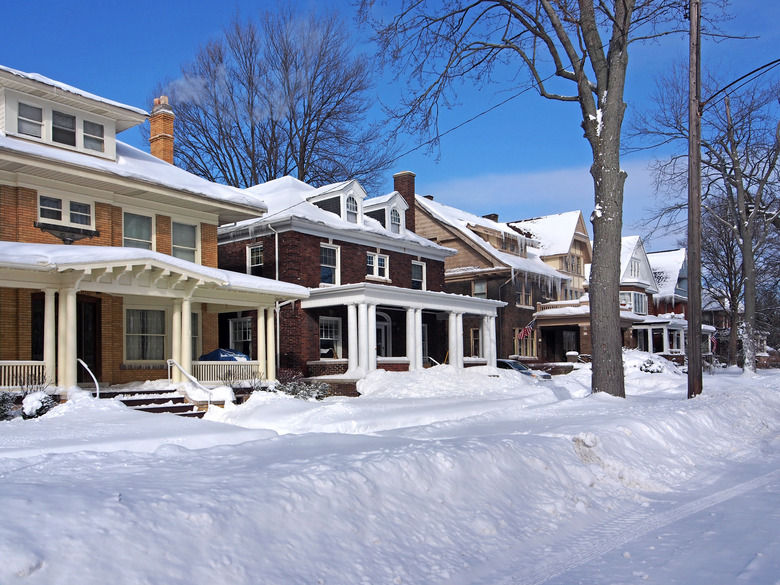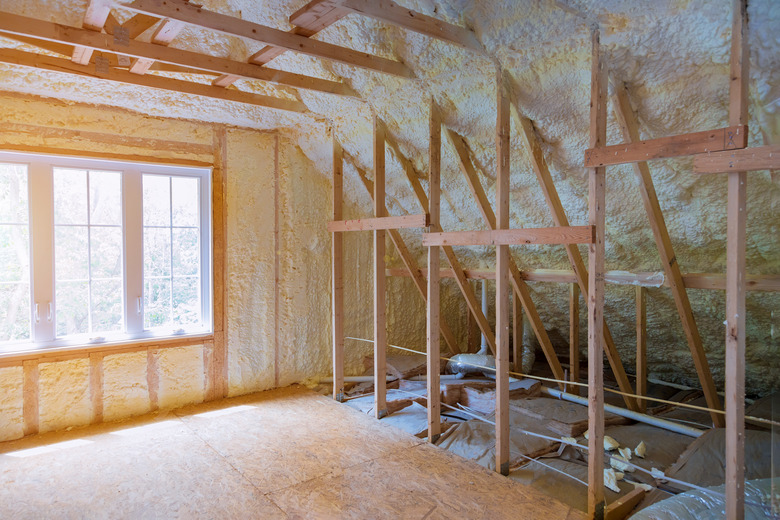11 DIY Ways To Reduce Heat Loss In Your Home
We may receive a commission on purchases made from links.
Everybody likes a toasty home in winter, and heat loss is a problem. It reduces the indoor temperature, costs you money and wastes energy. Reducing heat loss should be a top priority for a homeowner — especially when the weather gets dangerously cold — and while completely upgrading your home's insulation can cost a bundle, there are lots of simpler, less expensive ways to prevent heat loss and save on energy bills. In order to try some of these DIY ways to reduce heat loss, you'll need to understand the basic science behind heat loss in a home and where and why the heat goes out.
Understanding Heat Loss
Understanding Heat Loss
Heat loss occurs when you heat your home in cold weather and the warmth escapes to the outside air. When you lose a physical object, like a pair of gloves, you might be able to find it and resolve the problem. However, when you lose heat, it is gone for good. Your only option is to figure out how the heat escaped and take steps to stop it. It's good to do this as you prepare your home for winter each year.
Generally, heat transfers into or out of a home by three mechanisms: conduction, convection and radiation. These can work individually or in combination to transfer the warm air to the great outdoors or cool air from outside into the home. Each method of heat transfer is a little different.
In conduction, heat passes from the hot area of a solid object to the cool area of a solid object by the collision of particles. The molecules in a solid object cannot move around like gases do, so energy is stored in the vibration of atoms or molecules. Atoms or molecules with more energy transfer it to those with less energy by physical contact or collision. How does this work for your home? Hot air is transferred by conduction through the insides of the walls to the outsides of the walls.
In the process of convection, a heated section of liquid or gas moves to another area, transferring its energy to another location. Since hot fluids or gases are not as dense as cooler ones, they rise up, and cooler fluids or gases replace them. In your home, when warm air leaks out and cold air trickles in through gaps around windows or doors and other breaches, heat is lost by convection.
Radiation is a process where heat is transferred through electromagnetic waves, like from the sun to Earth. It does not require any atoms or molecules. The transfer can occur even in a vacuum. When your home is heated by the rays of the sun, it is because energy is being transferred by radiation.
The most efficient way to prevent or reduce heat loss in your home is to fortify the "skin" of the house: the external walls, the windows, the doors, the roof and the floors. You'll want to stop convection heat loss by caulking air leaks and limit conduction losses by beefing up the insulation. Within these general outlines, there are dozens of simple actions you can take and upgrades you can make to reduce heat loss and lead to better energy savings.
1. Air-Seal and Insulate Walls for Energy Efficiency
1. Air-Seal and Insulate Walls for Energy Efficiency
The amount of heat homeowners lose through air leaks is remarkable. One of the larger tasks that can limit home heat loss involves replacing the insulation in your walls. This is especially true in older homes since insulation technology improves every year. If you are doing it yourself, take your time and fill every gap. Don't compress the insulation and while you're there, seal the holes you find in the framing. Every hole, gap and compressed batt of insulation is one more way that heat escapes.
Remember that the same principles apply in summer when you are using air conditioning to cool the interior air. The more airtight your home, the less you'll spend on energy consumption in winter and summer.
2. Insulate Attics and Crawl Spaces
2. Insulate Attics and Crawl Spaces
Insulating walls packs a big punch when it comes to preventing home heat loss, but there are other spots in the house that also waste energy and increase heating bills. For example, attics need to be insulated if you want to keep the heat inside in winter. Crawl spaces and attics often have uninsulated ducts that allow heat to escape. Using duct wrap insulation around the existing ducts will give you an immediate payoff.
3. Insulate Roof Spaces
3. Insulate Roof Spaces
Since hot air rises, heat loss through the roof can be a real problem. It's not difficult to determine if your roof has insulation gaps or air leaks. Wait until the weather is frosty and then inspect your roof on a chilly morning. If there are areas with no frost, that's where there are leaks. The easiest way to prevent heat loss in this area of the house is by insulating the loft/ceiling area. Close up all ceiling gaps, taking special care around hatches and electrical and plumbing penetrations. If the attic is ventilated and not part of the heated living space, the ceiling between the living space and the attic is the primary focus for insulation.
4. Weatherstrip Exterior Doors
4. Weatherstrip Exterior Doors
Take a close look at your exterior doors when it is light outside to see if you spot daylight around the perimeters of the doorframe. Each place you see light is a gap that allows air to pass. Heat will leak out of those gaps in winter, increasing your energy bills.
Applying new weatherstripping is a cheap and easy DIY task that can take care of these air leaks. Remove old weatherstripping and apply the new product. You can buy self-adhesive rubber foam weatherstripping and get to work applying it on the frames of every door that leads outside. High-quality silicone rubber weatherstripping is another good choice, as it is longer-lasting and perhaps more attractive than other types of weather seals.
5. Install a Door Sweep
5. Install a Door Sweep
It's unrealistic to expect an exterior door to provide a complete seal against winter's cold. The door would have to be flush with the floor to do this, which would make it hard to open. That's why door sweeps are useful. These devices are narrow barriers of plastic, rubber, bristles or other materials that will block cold air from getting into your house underneath exterior doors.
How do you know if you need a door sweep? See if you can feel the wind or catch a glimpse of sunlight under your door. If so, it's time to add a door sweep or replace the one you have. Measure the width of the door and then cut the sweep to fit. Position the new sweep so that the flap just touches the top of the threshold below the door and then screw it in place.
6. Caulk the Windows
6. Caulk the Windows
As winter arrives, plugging up house leaks becomes an important item on a homeowner's to-do list. Every little hole lets in cold air that will dilute the air warmed by your heating system. When you go on the hunt for leaks, the perimeters of the windows are an important place to look, especially in older homes. To find the leaky windows, walk from room to room on a cold, windy day and feel for drafts.
Caulking windows is an easy, effective and inexpensive way to cut down your heating bills. You start by caulking the outside perimeter of leaky windows. Then, caulk the crack between the interior trim and the wall since this is the most likely entry spot for cold air.
7. Hang Insulating Curtains
7. Hang Insulating Curtains
Windows are made of see-through glass in order to let in sunlight. Holes around the perimeter of windows can be caulked, but window glass can also get cold and chill the room. Although thermal windows are more energy efficient and can cut down on the effect of that chill, even double-glazed windows allow more cold to pass through than an uninsulated wall.
A relatively inexpensive fix is insulating curtains that create an air gap between the warm room and the cold glass. Thermal curtains actually include a layer of foam between two layers of fabric that is intended to keep in heat. Thermal curtains reduce noise as well and make it easier to sleep by blocking light.
8. Install a Pelmet
8. Install a Pelmet
A free-hanging curtain — that is, a curtain hanging on a typical curtain rod — can become an additional energy drain if you're not careful. There is a space between the curtain and the window, and as the air in that space cools, it falls. More warm air from the room gets pulled into the space between the curtain and the window, and the cycle continues. To prevent this kind of airflow, install a valance that covers the top of a curtain rail. It's known as a "pelmet" and can either descend from the ceiling or attach to the wall above the window.
9. Seal Plumbing Leaks
9. Seal Plumbing Leaks
When you think about it, it makes sense that there are air leaks around plumbing pipes. They pass through the exterior walls, so any gaps around the pipes will allow a cold draft to enter. Fixing those is an easy matter with a can of expanding foam. Shake the can well and then squirt the foam into the gaps around the pipes. Remember that the foam will expand, so don't spray enough to completely fill the holes.
10. Seal an Unused Chimney
10. Seal an Unused Chimney
People have heated their homes with wood-burning fireplaces for centuries, but when you think about it a little bit, the old-style brick fireplaces are often extremely inefficient. You burn wood in the fireplace to create heat, but much of it goes up the chimney. When you have a fireplace that you don't use regularly, the chimney serves as a freeway through which the warm inside air can zip out into the cold night.
If your fireplace is modern, it might have airtight glass doors to seal off the opening, and that takes care of the problem. If not, you don't have to replace your fireplace — just install a special chimney balloon inside the chimney to put a stop to the air leaks. Blow up the balloon halfway, stuff it up the chimney and inflate it the rest of the way.
11. Cover Air Conditioners in Winter
11. Cover Air Conditioners in Winter
Air conditioners are much appreciated during hot summers, keeping our indoor living space cool and pleasant while the garden is sweltering. While an air conditioner is supposed to cool the house in summer, it will actually inadvertently cool the house in winter too by allowing cold air to get inside.
The simple solution is to remove it or cover it. You can and should remove window air conditioning units to prevent cold air from flowing through them. Wall units cannot be taken out easily. Instead, use an air conditioner cover and removable caulk to stop the leaks. Place the air conditioner cover over the outside of the air conditioner, attaching it in place with straps. Inside your house, put removable caulk around the edges of the air conditioner where it meets the wall or window.


